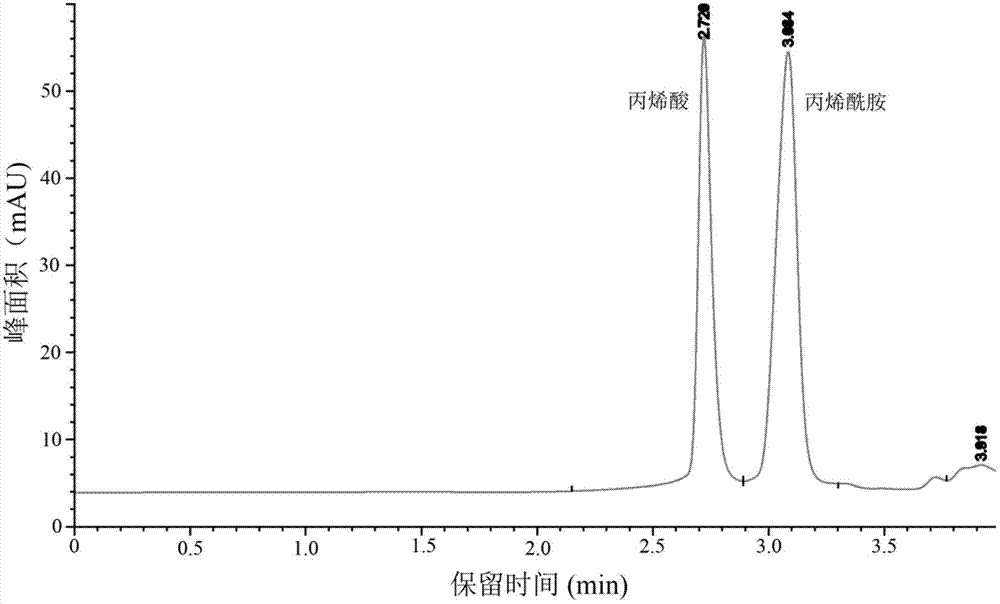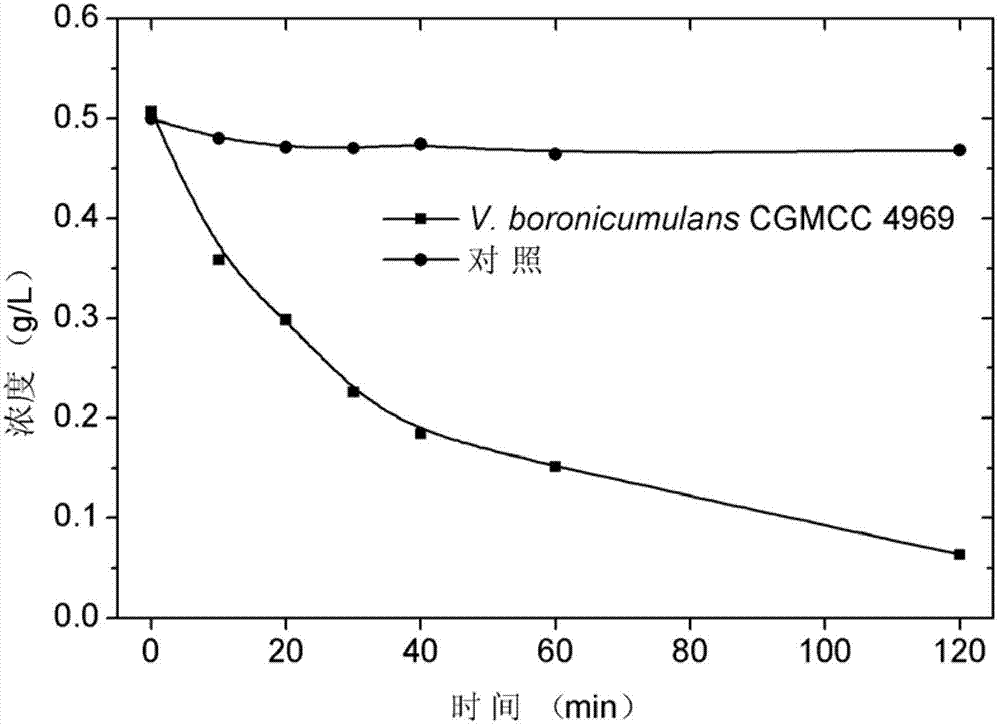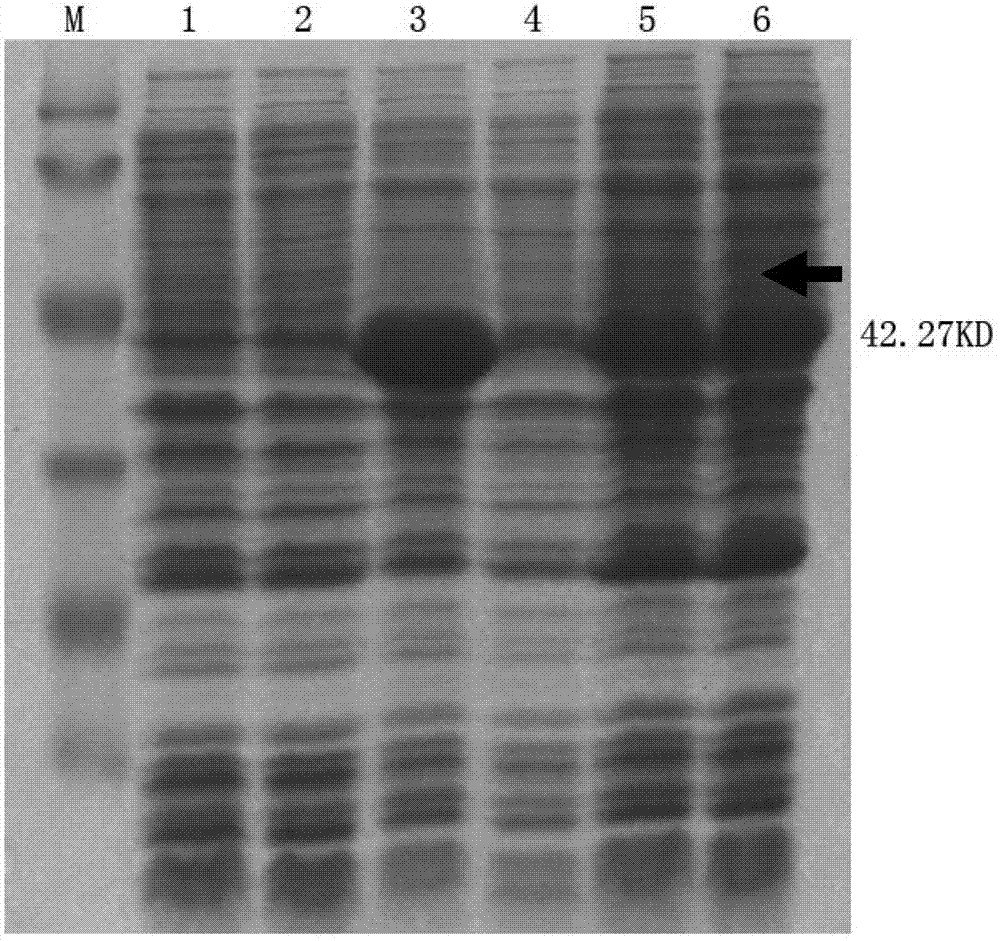Amidase gene of Variovorax boronicumulans CGMCC 4969, and its application in biological degradation of acrylamide
A technology of acrylamide and biodegradation, applied in the field of microorganisms, can solve the problem of no greedy phagocytosis degrading acrylamide
- Summary
- Abstract
- Description
- Claims
- Application Information
AI Technical Summary
Problems solved by technology
Method used
Image
Examples
example 1
[0015] Example one: V. boronicumulans Degradation of Acrylamide by CGMCC 4969 Strain
[0016] to be preserved V. boronicumulans CGMCC 4969 strain was streaked in a petri dish containing LB solid medium. The composition of LB medium is: peptone 10g / L, yeast extract 5g / L, NaCl 10g / L, solid medium plus agar powder 15g / L, pH7.2. After a single colony grows on the plate, pick a ring of single colony and inoculate it into LB liquid medium, shake it at 220 rpm for 24 h at 30°C, and collect the cells by centrifugation. Cells were suspended in 20 mmol / L sodium phosphate buffer (pH 7.0) containing 5.60 g / L acrylamide, and the degradation of acrylamide was detected by the HPLC method reported by Prabu and Thattheyus (2007). Such as figure 1 As shown, the retention time of the substrate acrylamide is 3.0 min, and the peak time of the product acrylic acid is 2.7 min. After 24 hours of transformation, the concentration of the remaining substrate acrylamide was 1.16g / L, the degra...
example 2
[0017] Example two: V. boronicumulans Acrylamide Degradation Kinetics of CGMCC 4969 Strain
[0018] The experimental method is the same as that of Example 1, and the initial concentration of the substrate acrylamide is 0.5 g / L. Take samples regularly to detect the reduction of acrylamide. get as figure 2 In the acrylamide degradation curve shown, the degradation half-life is 45 minutes, the reaction time is 120 minutes, the degradation amount of acrylamide is 0.46 g / L, and the degradation rate is 92%; while the substrate control hardly degrades.
example 3
[0019] Example three: V. boronicumulans CGMCC 4969 Amidase Gene Cloning
[0020] Pick up from the LB-containing solid medium with a sterile toothpick V. boronicumulans A single colony of CGMCC 4969 was inoculated into a 100 mL Erlenmeyer flask filled with 20 mL of LB liquid medium, and cultured in a shaker at 30°C and 220 rpm for 16 hours. The culture solution was centrifuged at 13,000 rpm for 5 min, the cells were collected and washed, and the genomic DNA was extracted using the MiniBEST Bacterial Genome Extraction Kit from TaKaRa Company.
[0021] Using greedy phagocytosis published in the Genbank database V. paradoxus S110 (accession number: CP001635.1) and V. paradoxus The amidase gene of EPS (accession number: CP002417.1) was homologously compared, and primers P3-1: 5'-ATGAGACATGGT GATATTTCGAGC-3' (SEQ ID No: 2) and P3-2: 5'-ATGAGAGTTCGG were designed CGTAGTTG-3' (SEQ ID No: 3), the primer was synthesized by Sangon Bioengineering (Shanghai) Co., Ltd. Synthe...
PUM
 Login to View More
Login to View More Abstract
Description
Claims
Application Information
 Login to View More
Login to View More - R&D
- Intellectual Property
- Life Sciences
- Materials
- Tech Scout
- Unparalleled Data Quality
- Higher Quality Content
- 60% Fewer Hallucinations
Browse by: Latest US Patents, China's latest patents, Technical Efficacy Thesaurus, Application Domain, Technology Topic, Popular Technical Reports.
© 2025 PatSnap. All rights reserved.Legal|Privacy policy|Modern Slavery Act Transparency Statement|Sitemap|About US| Contact US: help@patsnap.com



